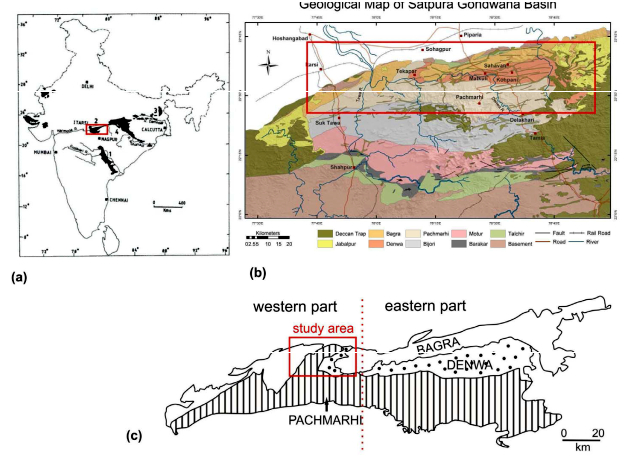Denwa Fm
Type Locality and Naming
Satpura Basin: The name Denwa was given by H. B. Medlicott (1873) to the beds characterized by red clays and subordinate yellow sandstones in the Denwa river, north of the Pachmarhi plateau, Madhya Pradesh. The Denwa river section of Pachmarhi plateau forms the type section of the unit. [Original Publication: Medlicott, H. B., 1873. Notes on the Satpura coal basin. Mem. Geol. Surv. Ind., 10 (1), 1-188.]
[Figure 1: a) Map of India showing Gondwana basins of the peninsular India with the red rectangle marking the Satpura Basin (after Bandyopadhyay, 1999); b) Geological map of the Satpura Gondwana Basin with the red rectangle showing the Upper Gondwana formations (after Ghosh et al., 2012); c) Geological map of the Upper Gondwana formations of the Satpura Gondwana Basin) (after Sengupta et al., 2016)]
Lithology and Thickness
Sandy claystone. Towards the base the Denwa Formation comprises about 120 m thick regular alternation of medium- to fine-grained sandstone bodies and red mudstone intervals with a sand-mud ratio of about 9:11. The mudstone intervals locally contain centimeter to decimeter-scale interlayers of fine-grained sandstones. Towards top the formation is 180 m thick and becomes mudstone-dominated with sand-mud ratio of 1:4. Ribbon-shaped bodies encased within pedoturbated mudstones represent the basic architecture of the upper Denwa succession (Maulik et al., 2000). The Denwa Formation is about 300 m thick. [See below - Depositional Setting for details on sedimentary structures.]
[Figure 2: A section of Denwa Formation exposed near Chhirka village ( after Sengupta et al., 2016)]
Relationships and Distribution
Lower contact
The Denwa Formation is conformably underlain by the Pachmarhi Fm, the latter gradationally passing into the former.
Upper contact
Regional extent
Satpura Basin: The Denwa Formation is found to continue physically from the eastern to the western part of the Satpura Basin exposed around villages of Sohagpur, Tekapar, Chhirka, Bichhua and Bagra Tawa.
GeoJSON
Fossils
Fish: Ceratodus sp. (Bandyopadhyay and Sengupta, 1999); Amphibian: Paratosuchus (Stanocephalosaurus/ Cherninia) denwai, Paratosuchus (Stanocephalosaurus / Paracyclotosaurus) crookshanki, (Mukherjee and Sengupta, 1998; Scoch and Milner, 2000; Damiani, 2001), Denwasaurus sp. (Chatterjee and Hotton, 1986), Brachyopidae indet. (Bandyopadhyay and Sengupta, 1999); Reptiles: Rhynchosauridae indet., Dicynodontidae indet. (Bandyopadhyay, 1988; Bandyopadhyay and Sengupta, 1999), Lonchorhynchinae indet. (Welles, 1993), Shringasaurus indicus (Sengupta et al., 2017); Palynomorphs and oribatid mites: Haradisporites mineri , Alisporites indicus , Brachysaccus indicus , Falcisporites stabilis, Krempipollenites indicus , Minutosaccus crenulatus , Samaropollenites speciosus, Satsangisaccites triassicus, Satsangisaccites royi, Scheuringipollenites tentulus, Denwasporite, Convertubisporites , Cyclogranisporites, yathidites, Podocarpidites, Chordasporites sp., Infernopollenites, Nidipollenites monoletus, Camerosporites, Convolutispora, Sahnites punchetensis, Oribatid Mites, Striatopodocarpites, Alternaria, Tetraploa, Curvularia, Nigrospora, Helminthosporium, Glomus, Entophlyctis, Microthyrium, cf. Microthyrites (Vijaya and Murthy, 2012).
Age
Depositional setting
Lower part of the Denwa Formation is characterized by an alternation of medium to fine grained, thick, sheet-like, sandstone bodies and red mudstone intervals having centimeter to decimeter scale fine-grained sandstone interlayers. The thick sandstone bodies are comprised of several groups of storeys, and individual storeys are made up of macroform strata reflecting frontal, oblique and vertical accretion. From the overall architecture, Maulik et al. (2000) depicted an alluvial plain setting comprising braided channel belts and associated floodplain/ basin for the lower part of the Denwa Formation.
Upper part of the Denwa Formation, characterized by conspicuous absence of thick multistoried sandstone bodies, is mudstone dominated succession that has ribbon-shaped bodies encased within pedoturbated mudstones. The ribbon-shaped bodies internally show inclined heterolithic (sand-mud) stratification representing lateral accretion of channel bars of high sinuosity rivers. Maulik et al. (2000) interpreted the upper part of the Denwa Formation to have deposited by a network of meandering channels laterally separated by well-developed and stable interfluve and floodplain areas. The authors attributed changes in the fluvial styles within the Denwa succession to changes in the aggradation rate, avulsion frequency and climatic setting (Maulik et al., 2000).
Additional Information
References
Bandyopadhyay, S. (1999): Gondwana vertebrate faunas of India. PINSA 65 A (3): 285-313. Casshyasp, S.M., Tewari, R.C. and Khan, A. (1993). Alluvial fan origin for Bagra Formation (Mesozoic Gondwana) and tectono-stratigraphic implications. Jour. Geol. Soc. India, 42, 262-279. Chatterjee, S. and Hotton III, N. 1986. The paleoposition of India: Journal of Southeast Asian Earth Sciences, 1: 145-189. Damiani, R.J. (2001) A systematic revision and phylogenetic analysis of Triassic mastodonsauroids (Temnospondyli:Stereospondyli). Zool. Jour. Linn. Soc.,133(4): 379-482. Maulik, P.K., Cha Kraborty, C., Ghosh, P., Rudra, D. 2000. Meso- and macro-scale architecture of a Triassic fluvial succession: Denwa Formation, Satpura Gondwana Basin, Madhya Pradesh. Journal Geological Society of India, 56, 489-504. Medlicott, H. B., 1873. Notes on the Satpura Coal Basin. Mem. Geol. Surv. Ind., 10(2), 133-188. Mukherjee, R.N., Sengupta, D.P., 1998. New capitosaurid amphibians from the middle Triassic Denwa Formation of Satpura Gondwanas, Central India. Alcheringa 22, 317–327. Sengupta, S, Ezcurra, M.D., Bandyopadhyay, S. (2017). A new horned and long-necked herbivorous stem-archosaur from the Middle Triassic of India". Scientific Reports. 7: 8366. DOI:10.1038/s41598-017-08658-8 Schoch R. and Milner, A.R. 2000. Stereospondyli. Handbuch der Paläoherpetologie – Encyclopedia of Paleoherpetology 3B: 1-203 Welles, S.P. (1993) A review of the Lonchorhynchinae trematosaurs (Labyrinthodontia), and a description of a new genus and species from the Lower Moenkopi Formation of Arizona. Palaeobios, 14(3), pp.1-24.

